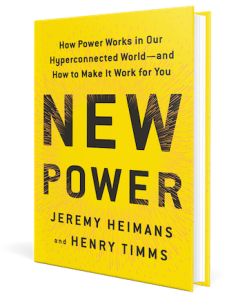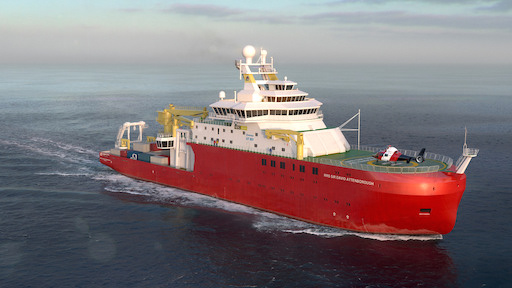 When I read or hear the word power, I almost always have a negative reaction. It can feel like the exact opposite of collaboration. But a new book – written about a different kind of “power” than we typically imagine – is changing my thinking.
When I read or hear the word power, I almost always have a negative reaction. It can feel like the exact opposite of collaboration. But a new book – written about a different kind of “power” than we typically imagine – is changing my thinking.
New Power: How Power Works in Our Hyperconnected World—and How to Make it Work for You is written by Jeremy Heimans and Henry Timms. It suggests specific strategies that organizations and movements can tap into as they take advantage of key aspects of hyperconnectivity – including crowd-sourcing and the enhanced ability to achieve active participation around important goals.
The authors themselves have practiced this new power in their own lives and careers.
 Jeremy Heimans is co-founder and CEO of Purpose, a home for building 21st century movements and ventures that use the power of participation to change the world. Since its creation in 2009, Purpose has launched several major new organizations including All Out, a 1.9 million-strong LGBT rights group, built the world’s first open-source global activism platform, and advised institutions like the Bill and Melinda Gates Foundation and Google.
Jeremy Heimans is co-founder and CEO of Purpose, a home for building 21st century movements and ventures that use the power of participation to change the world. Since its creation in 2009, Purpose has launched several major new organizations including All Out, a 1.9 million-strong LGBT rights group, built the world’s first open-source global activism platform, and advised institutions like the Bill and Melinda Gates Foundation and Google.
Henry Timms is President and CEO of 92nd Street Y, the renowned cultural and community center. More than 300,000 people visit 92Y annually, and millions more participate in 92Y’s digital and online initiatives. Henry oversees the organization’s 40+ businesses, including performing and visual arts programs; a series of talks and readings; a huge range of family and wellness programming; professional development opportunities; and more.
Heimans and Timms got the big idea for the book when they started talking together about the huge shifts going on in society as technology rapidly changes the way we live and communicate, and the importance of “looking at where the power is; who has it; and how they are using it.”
What is New Power?
New power is the antithesis of “old power,” or what many of us know as command-and control operations—a top-down hierarchical structure. New power is not only more flattened, but it relies on three important attributes, designated as ACE:
- Actionable: engaging others by encouraging people to do something meaningful;
- Connected: providing the opportunity for people to connect with each other, thereby creating a network;
- Extensible: or what I would call “adaptable,” but then you wouldn’t have the nice acronym (ACE). In other words, the idea or concept can be customized and changed to suit the needs of the user(s) – it’s able to accommodate change.
 Giving Tuesday is a primary example of new power detailed in the book. Coauthor Henry Timms and colleagues developed the Giving Tuesday idea and implemented it first in 2012. And, they did it in a “new power way:” Instead of branding it for themselves (e.g. #GivingTuesday92ndY), they widely shared the concept and encouraged other nonprofits to adapt and use it as they saw fit.
Giving Tuesday is a primary example of new power detailed in the book. Coauthor Henry Timms and colleagues developed the Giving Tuesday idea and implemented it first in 2012. And, they did it in a “new power way:” Instead of branding it for themselves (e.g. #GivingTuesday92ndY), they widely shared the concept and encouraged other nonprofits to adapt and use it as they saw fit.
As a result, countless organizations (including the A+ Education Partnership) have used Giving Tuesday as part of a fundraising program. You can read more about the genesis of Giving Tuesday here.
Becoming a New Power Leader
Can you think of a “new power” leader based on my limited description of new power? The authors suggest that a perfect example is Pope Francis. “He knows that being a leader today is not just [leading] within an institution, but as part of a larger participatory ecosystem.” (From Overview of Inside the Big Ideas of New Power, p. 2).
New power leaders possess three leadership capacities:
 Signaling—The nonverbal and verbal ways a leader uses speech, gestures, or actions to shift power to the crowd. As an example, instead of blessing the crowd (as previous popes have done), Pope Francis asks the crowd to pray for and bless him. He refused to live in the Papal Palace suite, and he declines to wear the regal attire, opting instead for a plain white robe.
Signaling—The nonverbal and verbal ways a leader uses speech, gestures, or actions to shift power to the crowd. As an example, instead of blessing the crowd (as previous popes have done), Pope Francis asks the crowd to pray for and bless him. He refused to live in the Papal Palace suite, and he declines to wear the regal attire, opting instead for a plain white robe.- Structuring—The systems, beliefs, and practices that a new power leader establishes. Pope Francis, for example, sent out the first questionnaire EVER to the laity of the church asking for suggestions about the church’s future direction.
- Shaping—The norms set by the new power leader that shift the focus away from formal authority. Using Pope Francis again as an example, he shifted the church’s dialogue from those issues that they opposed (abortion, homosexuality, etc.) to a more unifying theme: the concept of mercy.
Handle New Power with Care – “Boaty McBoatface”
Timms and Heimans are quick to point out that not all movements or ideas fit the new power model. In fact, they point to one example of an idea gone bad that many readers may remember.
A British scientific organization, preparing to launch a £200 million polar exploration ship, decided to engage the public to gain more publicity and support for the new vessel and its launch. Using more of an “old power” model, a press release was issued asking the public to submit names for the new boat AND suggesting names like “Endeavor,” “Explorer,” and “Shackleton” (the name of a famous arctic explorer).
The engaged public didn’t much like the closed nature of the request…e.g. “name our boat, but be sure to use our names.” Within days, the most popular name for the boat—by far—was Boaty McBoatface! The organization was appalled, ignored the crowd and named the ship “Sir David Attenborough” after the beloved British naturalist. Coverage of the controversy and the initial launch can be read here and here.
The British society forgot the tend to four important steps required of new power:
- Strategy: Do you need the crowd to get a better outcome?
- Legitimacy: Does your movement or organization have enough “street cred” to harness the crowd?
- Control: Are you willing to allow the crowd to have some of the power related to your movement or organization?
- Commitment: How willing are you to sustain the engagement of the crowd over the long-term?
Clearly, this is a case where simply naming the boat and announcing it by press release would have better met the organization’s style and structure. I must admit, quite honestly, that I like the Boaty McBoatface name and can imagine how much attention the boat might have drawn had it been so named!
Blending Power
Thankfully, the authors suggest a third alternative to new power and old power: Blending Power. As an example of an organization that successfully blended part of the old and part of the new, they point to the highly popular TED Talks. Anyone can google TED and find thousands of interesting short speeches about a wide range of subjects. And, they can watch as many as they want for free!
 But, if you want to attend an official TED event, you will need lots of money and prestige. In fact, the authors point out that such events often cost more than $25,000 to attend and even that level of investment doesn’t necessarily guarantee an invitation!
But, if you want to attend an official TED event, you will need lots of money and prestige. In fact, the authors point out that such events often cost more than $25,000 to attend and even that level of investment doesn’t necessarily guarantee an invitation!
To avoid charges of elitism and open the process to new ideas and insights from less-famous presenters, the TED organization (using the “E” for extensible from the ACE criteria) began sanctioning TEDx talks that can be offered by organizations agreeing to follow specific TED guidelines. As a result, more than 30,000 TEDx talks have been delivered in 130 countries!
Read the Book
I can’t stop thinking about this book and its implications—both for A+ and the future of so many organizations: nonprofits, schools, governments. I’ve only described a few aspects of new power. As we rely more and more on the internet and on crowd-sourcing, there is an opportunity to bring people together for good by either blending power or embracing the new power.
At a time when everyone seems to be in a bad mood and when people’s political views are becoming even more stratified, the time is ripe for this type of thinking. Read the book. I think you’ll find it intriguing. And, then, let me know your thoughts!
Resources
►Here’s How to Leverage New Power within Your Organization (Jeremy Heimans)
https://www.tinypulse.com/blog/leadership-warriors-jeremy-heimans-new-power
► Both Heimans and Timms explain the New Power matrix (5 min)
https://www.youtube.com/watch?v=xo8Hwe6B9l0
► Here’s the Ted Talk by Jeremy Heimans
https://www.ted.com/talks/jeremy_heimans_what_new_power_looks_like
► Guardian interview of Heimans
https://www.theguardian.com/politics/2018/apr/20/new-power-jeremy-heimans-social-media
► Henry Timm’s keynote to foundations
https://www.youtube.com/watch?v=ExU0C7VAGN4
►Next Big Idea Podcast
https://podcasts.apple.com/us/podcast/power-why-you-have-more-than-you-think/id1482067226?


0 Comments on "Organizations Can Put “New Power” to Work for Good"